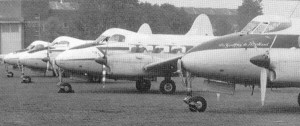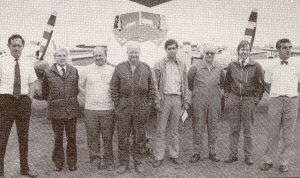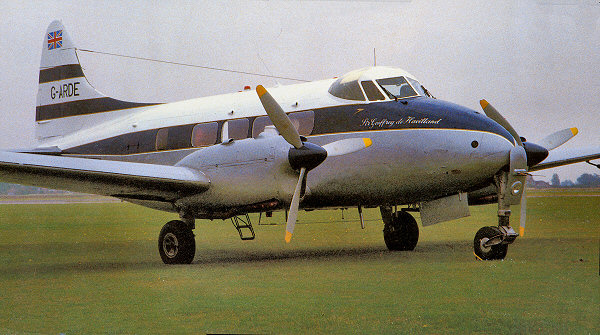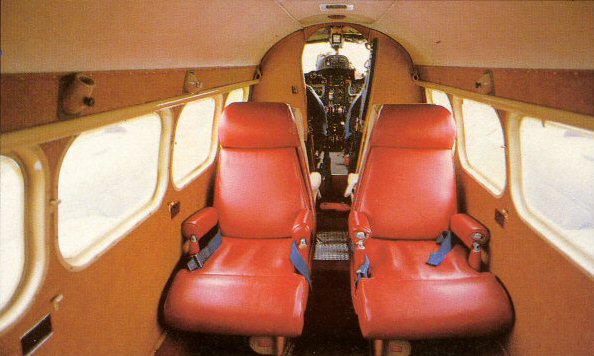207 SQUADRON ROYAL AIR FORCE HISTORY
DOVE AT 40
FlyPast December 1985
Reproduced with thanks from the December
1985 edition
of FlyPast with permission from the publishers, Key
Publishing Ltd. www.flypast.com
[those that served on 207 Squadron are highlighted in bold]
Griffin formation bore down on Hatfield, Herts, in a creditably tight box. They made a series of low sweeps across the airfield, looking for all the world like a flight of attackers attempting, once again, to bring the famous production line to a halt.
They did achieve the latter, but using aircraft with a benign name - the de Havilland DH.104 Dove. The Hatfield production line these days does not churn out war-winning Mosquitoes, but economy-sustaining BAe 146 feederliners. The line was ground to a halt, not through battle damage, but through the workforce witnessing a flypast to commemorate the 40th Anniversary of the first flight of the Dove - September 25, 1945. One of the few designs conceptualised with the Brabazon Committee that was to aspire to true commercial success, the Dove attained unheard of production to the tune of just over 500. G-AGPJ, the prototype, was designed and built with an eye to the peace-time plummet in military aircraft production, with great speed.
Thanks to the recent demobbing of the former RAF 32 Squadron Devon C.2/2s and the Royal Navy's partial retirement of their Sea Devons, interest is in resurgence at the moment.
Under the initiative of Rodney Small, no less than five Doves/Devons assembled at Cranfield, Beds, in readiness for a celebration formation fly-by at the birthplace of the breed, Hatfield. Particular praise should go to the Rotterdam-based G-BLRN [WB531] which made a long journey to join in.
Those taking part well reflected the new role of the DH.104, no longer a workhorse, now flown for fun and sentiment. Only G-ASMG, British Aerospace's immaculate Mk-8, is still used for business in the strict sense. The BAe fleet of 'hacks' is to be replaced shortly. BAe have already acquired a Jetstream for use out of Brough, Humberside, but will probably settle for a mixture of light twins and Jetstreams.
Oldest in the formation was VP955/G-DVON piloted by Lionel Thatcher and Mark Laing [sic - former 207, Sqn Ldr Mike 'Rosie' Lanng] who are part of a group of six calling themselves the 955 Preservation Group operating out of Staverton, Glos. There is a monthly standing charge to each member and then direct operating costs as they are incurred.
 Impressive line-up of shapely noses on the Cranfield turf |
 Line-up of pilots and crew involved in the anniversary flypast. Rodney Small who coordinated the event is third from the left |
Lionel says that the Devon used 30gph with "realistic" operating cost at around £150 per hour. If a full complement of passengers can be found, then sorties to France and the Channel Isles (recent venues) are a comfortable and economic proposition. Lionel was much in praise of Staverton-based Colt Aviation, who have specialised in heavy maintenance on the type for some time.
Lionel has great feelings for the Devon. His first flight, with the Air Training Corps, was in VP972 "umpteen-blank years ago". VP955/G-DVON was handed over to the RAF in August 1948.
Eleven production slots behind at Hatfield was Vic Norman's VP962/G-BLRB. Handed over to the service in November 1948, VP962 served in West Germany from 1965 and was to be found in Saigon, Vietnam, with the Air Attache during the mid-1970s. Vic, who is a professional display pilot currently 'doing the rounds' in a Stampe SV and a Zlin Z.50L uses the aircraft as a 'family hack' giving him flexibility to get away from it all when he wishes. The family, courtesy Romeo Bravo had a holiday in France this year. Vic bases the aircraft at Kemble, Gloucestershire.
From Rotterdam came G-BLRN, owned by four Dove-loving Dutchmen, Pet Delhaas, Abe and Eric van do Schraaf and Clive Simpson. They plan to undertake air display work next year in Romeo November, by which time it may well have made the Dutch civil register. Peter has a strong liking for the type. He once ran the Dutch station for long-lamented Channel Airways, who operate a fleet of Doves and Herons among others. The consortium operates this aircraft on very similar lines to the Staverton group.
G-BLRN started life as Devon WB531, joining the RAF in July 1949. It is another well travelled example, having been used for time by the Air Attache in Djakarta, Indonesia.
Rodney Small's G-ARDE Sir Geoffrey Havilland was delivered to an Italian corporate customer in June 1952 as I-TONY. It returned to the UK in November 1960 taking up the identity Delta Echo. After much faithful service with the brewery Inde Coope it joined Hunting Surveys in February 1970 and it was from them that Rodney acquired the aircraft in 1984.
The group who have restored the aircraft to pristine condition were suitably rewarded with the 1985 Prize at the Great Warbirds Display at West Malling. First appearance at an airshow bringing their first prize! Delta Echo was painted up over the winter following a complete strip down. The interior restoration is of the highest standard showing just what a plush form of transport the Dove represents.
There were initially six founder members of this team. A bigger job than the extensive restoration was the construction at Cranfield of a hangar specifically for the aircraft. With an eye to airshow work, the choice of British Overseas Airways Corporation livery was a wise one. This is a representative scheme for a Dove and also makes it attractive and different proposition on a flight line.
British Aerospace's example, G-ASMG is by comparison to the others a youngster. A Mk.8, it was built for the electronics concern BSR and handed over to them in November 1963. It was traded back in 1965 (BSR eventually going for the Dove successor, the HS.125 executive jet) and became a company 'hack'. Immaculately maintained, it has given sterling service since.
Forty years on, the Dove still has a bright future, although more as a very adaptable 'vintage' acquisition.

Celebration line-up at Cranfield, September 25th [1985]

Sir Geoffrey de Havilland, G-ARDE, in BOAC colours

Beautifully restored interior on Rodney Small's Mk.6 G-ARDE

Formating through the 'clag' on Vic Norman's Devon en route
to Hatfield [VP962/G-BLRB]
all photos by Duncan Cubitt